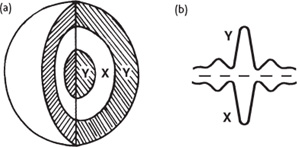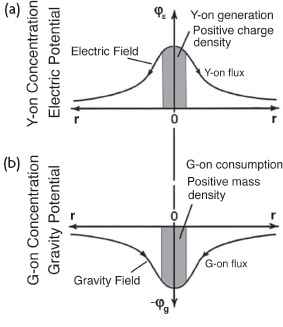Secrets of Antigravity Propulsion (16 page)

Subatomic particles would not emerge as mass points, as standard physics would conceive them, but as wave patterns configured of etheron concentrations whose magnitudes vary cyclically through space.
Figure 4.2a illustrates the spherical, shell-like geometry of the X-Y wave pattern forming a proton, and figure 4.2b presents a stylized cross-sectional view of the variation of the X and Y ether concentrations in the core of a proton.
This would chart the proton’s electric potential field, a positive charge polarity corresponding to a high-Y/low-X core concentration.
The negatively charged antiproton would have a low-Y/high-X core concentration, hence X and Y magnitudes that were of reversed polarity.
The wavelength of this electric field pattern would equal the particle’s Compton wavelength, which is numerically equal to the wavelength of the photon that would result if the particle’s rest mass was converted entirely to energy.
This Compton wavelength, λ, is mathematically quantified as: λ = hc/E, where
E
is the rest mass energy of the particle, h is Planck’s constant, and c is the velocity of light.
The proton’s Compton wavelength, for example, would measure just 1.32 × 10
-13
centimeters.
The electron’s wavelength would be about two thousand times longer.
Subquantum kinetics calls this wavelike field the particle’s Turing wave, in honor of the British cyberneticist Alan Turing.
Turing was the first to demonstrate that reaction-diffusion systems could form such wave patterns through a process he termed
morphogenesis.
One of the successes of subquantum kinetics is that its prediction that the nucleon’s core electric field should be contoured with a Compton wavelength periodicity was confirmed almost thirty years later by nucleon scattering experiments.
12
The quark model, by comparison, failed to anticipate the nucleon’s wave character.
The standard quantum mechanical view proposes modeling the location of the subatomic particle as a wave packet, a superposition of a series of linear electromagnetic waves.
It has long been recognized, however, that the wave packet has the problem that over time it spontaneously broadens and eventually disperses, leaving the particle entirely unlocalized.
The subatomic particles that Model G forms, though, do not disperse over time.
Their periodic ether concentration structure is continually regenerated by order-creating etheric reaction-and-diffusion processes.
The cyclical transformation of X into Y and Y into X depicted in figure 4.1 is what allows the model G reaction system to create and maintain the subatomic particle’s stationary wave pattern.

Figure 4.2.
(a) A cross-section of the concentric, shell-like ether concentration
pattern making up a proton showing alternating Y and X ether maxima.
(b) Radial variation of the X and Y etheron concentrations forming the
proton’s stationary electric potential wave pattern.
The peak-to-peak shell
wavelength would equal the particle’s characteristic Compton wavelength.
(P.
LaViolette, © 1995)
An analysis of the Model G reaction system indicates that there is a stable steady state in which the core Turing wave of an initially neutrally charged particle becomes biased away from its zero-charge steady state.
Upon making the transition to this state, the particle acquires a unit of electric charge that allows it to create its long-range electric field.
This is not an assumption; it is a characteristic that emerges as a consequence of the postulated reaction system.
In a positively charged particle, for example, the electric field pattern would become positively biased at its center, its high-Y core concentration rising and its low-X core concentration falling to adopt bias levels similar to those shown in figure 4.2b.
In a negatively charged particle such as an electron, the electric field pattern would instead be negatively biased, the Y core concentration being depressed and the X core concentration being elevated.
Recent particle scattering observations that elucidate the charge distribution in the core of the nucleon confirm this wave pattern bias prediction.
13
Subquantum kinetics predicts that a particle’s electric charge generates its gravitational mass and associated gravity potential field through the reverse, ether reaction G ← X, which converts X etherons (X-ons) into G etherons (G-ons).
Although the ether reactions shown in figure 4.1 proceed predominantly in the forward direction (to the right in the figure), such reverse reactions also exist, although they proceed at an almost negligible rate.
But even though the reverse X-to-G reaction produces a very small G flux, without it particles would be unable to generate their gravity fields.
Through this reaction, an increase or decrease of X arising from either a negative or a positive charge polarity translates into a corresponding increase or decrease of G.
Accordingly, subquantum kinetics predicts that there should be two gravitational mass polarities, each correlated with a corresponding electric charge polarity.
That is, positively charged particles such as protons, which have low X-on concentrations in their cores, should produce a central gravity potential well, while negatively charged particles such as electrons, which have high X-on concentrations in their cores, should produce a central gravity potential hill.
Consider, for example, a positively charged particle such as a proton, which would maintain a high Y-on and low X-on concentration at its center.
The low X-on concentration would correspondingly reduce the rate at which G-ons were created in the center of the proton via the X-to-G reaction.
In other words, the particle’s positive charge would generate a corresponding positive gravitational mass; see figure 4.3.
The reduced X-on and G-on core concentrations resulting from the X-on and G-on production rate deficits would induce X-ons and G-ons to diffuse inward from surrounding regions.
Also, the elevated Y-on core concentration arising from the Y-on production rate surplus would induce Y-ons to diffuse radially outward to the environment.
These radial diffusive fluxes would generate the long-range electric and gravity potential fields that surround the proton’s core.

Figure 4.3.
(a) The electric potential field of a proton (positive Y-on concentration) being created by a central positive charge density (Y-on production rate surplus).
(b) The negative gravity potential field of a proton (negative G-on concentration) being created by a central positive mass density (G-on production rate deficit).
Arrows indicate the directions of Y-on and G-on diffusion that create the respective fields.
The X-on concentration profile, not shown, is the inverse of the Y-on profile.
(P.
LaViolette, © 2007)
The electric field would consist of a 1/r decline in the particle’s X-on and Y-on etheron concentration biases, and the gravity field would consist of a 1/r decline in the particle’s G-on concentration bias.
Both fields mathematically conform to the requirements of classical electrostatics and gravitation.
Their 1/r character is not assumed ad hoc, but rather emerges as a natural consequence of radial etheron diffusion.
In his
Lectures on Physics,
the Nobel laureate physicist Richard Feynman proposed an etheron diffusion model not too different from this as a way of understanding how a subatomic particle generates its 1/r energy potential field.
14
These concentration biases and etheron diffusive fluxes would be just the opposite for an electron.
A negatively charged particle such as an electron would maintain high X-on and G-on and low Y-on concentrations in its core, which would constitute the negative charge and negative mass state.
This X-on and G-on production rate surplus would induce X-ons and G-ons to flow outward to surrounding regions and the Y-on production rate deficit would induce Y-ons to diffuse inward from the environment.
These fluxes would generate the electron’s long-range electric and gravity potential fields.
A proton’s gravity well would have a matter-attracting effect on surrounding neutral matter, while an electron’s gravity hill would have a matter-repelling effect on surrounding neutral matter.
Austrian astrophysicist Sir Hermann Bondi described this gravity-field-generating mass with the term “active gravitational mass,” distinguishing it from passive gravitational mass, which characterizes the particle’s tendency to respond to an external gravity field, and from inertial mass, which characterizes the particle’s tendency to resist changes in velocity.
Electrically neutral matter, containing equal numbers of protons and electrons, would have a net positive active gravitational mass, since the proton’s positive gravitational mass is slightly greater than the electron’s negative gravitational mass.
That is, the proton’s gravity well is only partially canceled out by the electron’s gravity hill, and as a result, the electrically neutral atom is left with a residual matter-attracting gravity well.
Particles producing gravity wells would attract neutral matter, whereas particles producing gravity hills would repel neutral matter.
It should be kept in mind that subquantum kinetics grew out of the intention to apply chemical kinetics concepts to microphysics and the realization that a reaction kinetic ether could provide a viable framework for describing the formation of subatomic particles.
I did not devise it in a concerted attempt to explain the phenomenon of electrogravitics.
In fact, I was initially somewhat concerned that the theory predicted two mass polarity states, each correlated with a corresponding electric charge polarity, but was later relieved upon discovering Brown’s work.
Subquantum kinetics accounts for gravitational force in terms of the action of gravity potential gradients on material bodies and not by introducing ad hoc assumptions about dimensional warping.
Gravity potential fields move a particle by affecting the ether reactions that generate the particle and form its Turing wave.
This reaction-kinetic approach is something quite foreign to classical physics and quantum mechanics, which consider a proton or an electron as a relatively immutable structure.
Not so in subquantum kinetics.
The subatomic particle’s etheron population is continuously transformed and renewed.
A particle’s Turing wave structure is re-created every instant, as etheron diffusion balances etheron creation or dissolution at each point in space.
The subatomic particle, then, maintains its field structure in a dynamic steady state, or what the Hungarian systems theorist Ludwig von Bertalanffy would call a
Fliessgleichgewicht
, a “patterned flow equilibrium.”
Or, using a term coined by the Russian Nobel laureate Ilya Prigogine, we would refer to subatomic particles as “dissipative space structures.”
The presence of an external field gradient will necessarily affect the position of a particle because it will disturb the equilibrium of the reaction processes that continually generate the particle’s Turing wave pattern.
That is, the field gradient will distort the particle’s space structure by raising (or lowering) the etheron concentrations more on one side of the particle than on the other.
Because the steady-state condition tends to create a symmetrical space structure for the particle, any such departure from symmetry will induce a stress, or a state of disequilibrium.
This stress is identified with the electrostatic or gravitational force that this electric or gravity potential field exerts on the particle.
The reaction system relieves this stress and momentarily gains greater symmetry by accelerating or moving the particle’s regenerating wave pattern either up or down the field gradient, the direction of movement depending on whether the field’s action is attractive or repulsive.
